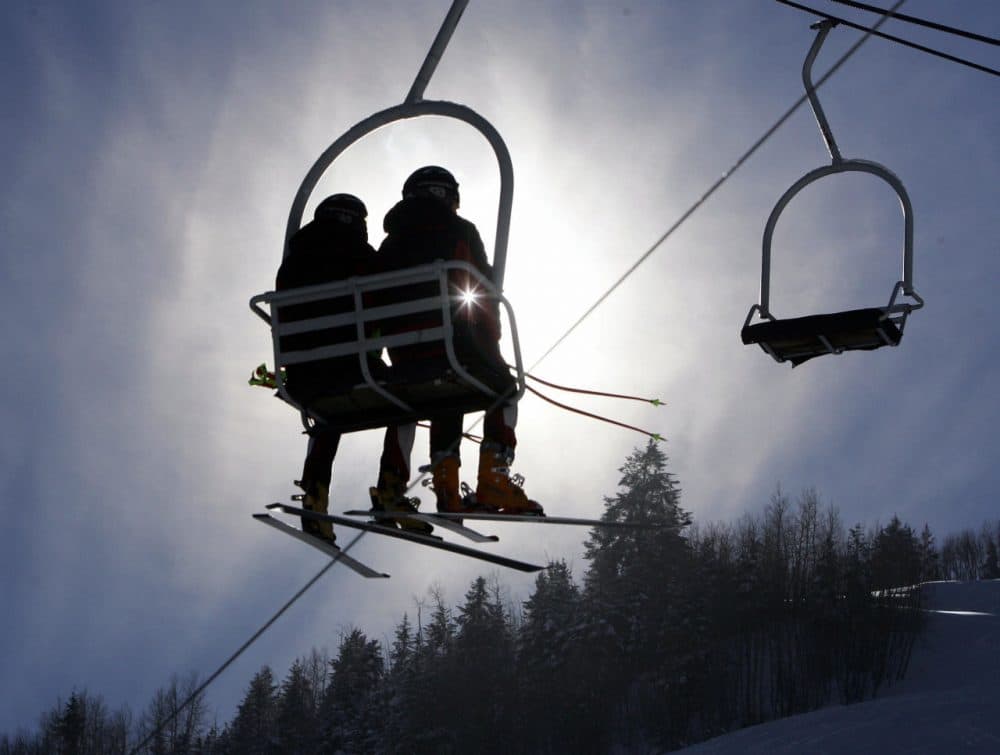Advertisement
How Climate Change Is Impacting Winter Sports
Resume
In July 2011, Arnaud Temme and three of his friends climbed a "rather involved route" in the Bernese Alps in Switzerland.
Arnaud Temme is a geographer at the University of Wageningen in the Netherlands. He’s also an accomplished rock climber, and a guy smart enough to consult a guidebook before setting out on a route described as challenging, but not dangerous.
"We, however, encountered rather a lot of rock fall," Temme says. "Couple stones hit me on the helmet. One hit me on the shoulder. And it was a — let’s say unpleasant, dangerous experience. We did descend on the other side, and everything turned out to be totally fine. Just a little bit of blood. No scar."
I just couldn’t sit back and not do something about it, because it was affecting so much of my life, and my being, and it hurts deep down.
Jeremy Jones, professional snowboarder
No scar, but considerable confusion. The route Arnaud Temme had chosen that day was supposed to have been safe. The guidebook said so.
"The guidebook was less than 10 years old," says Temme. "Which, up until 10 years ago, was totally fine to have a 10-year-old guidebook."
Temme, being a geographer, designed a study. He found that guidebooks can’t keep up with changing conditions. The only reliable update is whatever’s been tweeted by the most recent climber on the route he’s considering.
Temme says rocks once under snow and ice are in motion, and the permafrost that once froze boulders in place is releasing them to gravity.
Trouble On The Slopes
But how many people are climbing around rocks in the remote Swiss Alps? Stick closer to the ski lodge, you’re good, right? Nothing to worry about. Maybe not.
"When people see snow, they’re happy, and therefore they spend money," says David Polivy, owner of Tahoe Mountain Sports in Truckee, California. "When they see rain, especially in the winter time, they get very dreary."
Polivy's business is dependent on happy people carrying skis over their shoulders in the winter and rafting down the area’s rivers in the summer. He’d like to see more of both, but the climate hasn’t been cooperating.
"It’s not just our winter business," Polivy says. "The effects of climate change are year-round, and that can really be seen in the summertime as well, when we don’t have enough water in our waterways. So the rafting companies, which are small and seasonal, those guys don’t even open up."
Maybe you weren’t aware of the threat to outdoor sports posed by falling rocks and disappearing rivers. A lot of the most dire warnings regarding climate change have referred to rising sea levels and the increasingly severe storms that have battered the coasts from Louisiana to New York. But it can be argued that what’s happening in the mountains is an excellent indication of how serious the consequences of climate change can be.
"When it comes to climate change," Ashley Perl, "Aspen is like the canary in the coal mine."
Perl is the climate action manager for the city of Aspen, Colorado.
"So the miners used to take the canary into the coal mine, and when the canary keeled over, they knew the air quality was bad and they should get out. So here in Aspen, we see the effects of a change in climate a lot sooner than other places, so I guess the thought is, when you see Aspen keel over from climate change, it’s time to get out."
“And go where?” one might ask. But first let’s learn something about the tune that canary in Colorado is singing. In terms of the number of days upon which snow falls or snow can be made — and in Aspen such days are a very large concern — current winters are almost a month shorter than were the winters of three decades ago. So what?
"It takes three consecutive days of freezing temperatures before you can make snow," Perl says. "We really rely on those consecutive freezing days. So, when people show up in Aspen at Thanksgiving or even Christmas and expect the great powder that they’ve come to know us for, that we have that snow available.
When people see snow, they’re happy, and therefore they spend money, when they see rain, especially in the winter time, they get very dreary."
David Polivy
A Call To Action
This winter there has been snow in the western mountains. For much of the previous several winters, there hasn’t been. And though some of the folks dependent on skiing tourists are just happy for this season’s reprieve, Perl is looking ahead.
"If federal policy doesn’t really get started going in reducing greenhouse gas emissions," Perl says, "then all the great efforts of all the local communities could fall flat, because we rely so much on what happens at the federal level."
Perl says those local efforts have transformed Aspen into a community running on 100 percent renewable energy. They haven’t made it snow. But according to Matt Abbott, environmental project manager for Park City, Utah, good seasons at the ski centers are good for more than just business.
"Ski areas definitely attract Type A personalities, very competitive athletes and business people and everything else," Abbot says. "So, I think there is a certain swagger to, 'Yeah, we can beat this.' "
Among those combining that swagger with eyes wide open to the damage done is Jeremy Jones, a professional snowboarder who’s built a foundation called Protect Our Winters.
"You know, the last thing I was looking to do was take on climate change," Jones says, "but I just couldn’t sit back and not do something about it, because it was affecting so much of my life, and my being, and it hurts deep down."
Jones has come to understand that much more than weekend recreation is at stake. Like Temme, the climber clobbered by falling rocks, Jones has seen the glaciers recede. He’s seen some of them disappear. And that has changed him.
"I’ve now realized that the least of our problems will be the chairlift running if we stop having snowfall," Jones says, "just ‘cause it makes up so much of our water source, and we see the effects of that in California right now."
I apologize in advance. The temptation is too great. Whether or not you’re a skier, a snowboarder or a river rafter, ask not for whom the canary chirps, it chirps for thee.
This segment aired on February 27, 2016.
